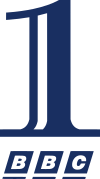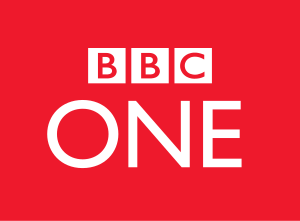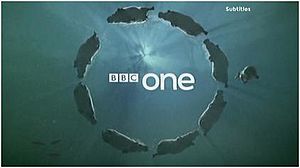BBC One facts for kids

Logo used since 2021
|
|
| Country | United Kingdom |
|---|---|
| Broadcast area | |
| Network | BBC Television |
| Headquarters | London |
| Programming | |
| Language(s) | English |
| Picture format | 1080i/1080p HDTV (downscaled to 576i for the SDTV feed) 2160p UHDTV (ongoing trials, available on BBC iPlayer for certain programmes only) |
| Ownership | |
| Owner | BBC |
| Sister channels | |
| History | |
| Launched | 2 November 1936 |
| Former names |
|
| Links | |
| Webcast | BBC One on BBC iPlayer (UK only) |
| Availability | |
| Terrestrial | |
| Freeview |
|
BBC One is a very popular TV channel in the UK. It's owned by the BBC, which is a public broadcasting company. This means it's funded by a special fee that people pay, not by commercials. So, you won't see any ads interrupting your shows!
BBC One is the main channel for the BBC. It shows a wide variety of programmes, like BBC News updates, exciting dramas, fun entertainment shows, and live BBC Sport events.
The channel first started on 2 November 1936. Back then, it was called BBC Television Service. It was actually the world's first regular TV service with good picture quality! Later, it changed its name to BBC TV in 1960. When a second BBC channel, BBC Two, launched in 1964, the main channel became known as BBC1. Finally, in 1997, it got its current name, BBC One.
BBC One is super popular. In 2019, it had the most viewers of any TV channel in the UK. A big study in 2013 even called BBC One the highest-quality TV channel in the world!
Contents
How BBC One Started and Grew
The Very First Days of BBC Television
The BBC began testing its TV programmes in London in 1932. The channel officially started broadcasting regularly on 2 November 1936. Its first home was a special part of Alexandra Palace in London.
However, on 1 September 1939, just before World War II began, the channel suddenly stopped broadcasting. The government was worried that the TV signals could help enemy planes find London. The last show they aired was a Mickey Mouse cartoon called Mickey's Gala Premier.
BBC Television returned to air on 7 June 1946. An original announcer, Jasmine Bligh, welcomed everyone back. Twenty minutes later, they showed the same Mickey Mouse cartoon that had been the last programme before the war.
Becoming BBC1 and Adding Colour
For a long time, the BBC was the only TV broadcaster in the UK. But then, ITV started broadcasting in 1955. This competition made the BBC change how it worked.
BBC Television became BBC1 when BBC Two launched on 20 April 1964. BBC2 used a newer, more advanced picture system. To watch both channels, people needed a special TV and two antennas! BBC1 moved to its own special building, Television Centre, in 1969.
On 15 November 1969, BBC1 officially started broadcasting in colour. This was a big deal! Even if you had an old black and white TV, you could still watch the colour shows, but they would appear in black and white.
Between 1973 and 1977, BBC1 was incredibly successful, reaching almost half of all TV viewers.
In 1983, BBC1 launched Breakfast Time. This was the first morning TV show across the whole UK. It was very popular for a while.
Changes in the 1980s and 1990s
In 1984, Michael Grade became the boss of BBC1. He wanted to make the channel even better. He brought in new shows like Wogan and the famous soap opera EastEnders. He also changed the schedule to make it easier for people to watch their favourite programmes.
EastEnders became a huge hit, sometimes watched by 20 million people! This helped BBC1's audience grow a lot.
In 1985, the children's TV block got a new look and name: Children's BBC. For the first time, it had its own special presenters, like Phillip Schofield. Before this, regular BBC announcers introduced children's shows.
BBC1 also started broadcasting in stereo sound in the late 1980s. This made shows sound much better. Later, in 1998, widescreen programmes were introduced for digital TV.
In the 1990s, the BBC started buying more shows from independent production companies, not just making everything themselves. This brought even more variety to the channel.
By the late 1990s, BBC1 decided to focus more on serious factual programmes, educational shows, and dramas. They wanted to offer high-quality content that you couldn't find anywhere else.
The 2000s: New Bosses and Big Hits
Lorraine Heggessey became the head of BBC One in 2000. During her time, the channel's audience share went down a bit, but this was happening across all UK channels because more digital channels were available. However, in 2001, BBC One became more popular than its main rival, ITV, for the first time since 1955!
Lorraine Heggessey made some big changes. She moved the main news programme to 10 PM and commissioned new dramas like Waking the Dead and Spooks. She also launched the very popular dancing show Strictly Come Dancing.
In 2002, she changed the channel's on-screen look. The famous "globe" logo, which had been used in different ways since 1963, was replaced by new "Rhythm & Movement" idents (short clips shown between programmes) that featured people dancing.
One of her most famous decisions was bringing back the science-fiction show Doctor Who. It had stopped being made in 1989, but Lorraine Heggessey helped bring it back to BBC One in 2005. The new Doctor Who became a huge success!
Peter Fincham took over as head of BBC One in 2005. He commissioned more successful shows like Robin Hood and The One Show, which is a popular evening magazine programme.
In 2007, Peter Fincham decided to stop showing the Australian soap opera Neighbours on BBC One after 21 years. This was because the price to show it became too high. Neighbours then moved to Channel 5.
Modern BBC One: What's On Now
BBC One aims to be the most popular TV service in the UK, offering a wide range of high-quality programmes. It's the main place for big UK and international events and tries to show things that reflect all parts of the UK.
Here are some of the most watched shows (not including sports or news):
| Rank | Show | Episode | Number of viewers (millions) |
Date |
|---|---|---|---|---|
| 1 | EastEnders | Den divorces Angie. | 30.15 | 25 December 1986* |
| 2 | New Year Episode – Sharon is stalked. | 28.00 | 1 January 1987* | |
| 3 | Only Fools and Horses | "Time on Our Hands" | 24.35 | 29 December 1996 |
| 4 | EastEnders | Everyone is telling Mark to tell Michelle about his illness. | 24.30 | 2 January 1992* |
| 5 | Michelle tells Den that she is pregnant. | 24.15 | 7 January 1988* |
BBC One shows a lot of different types of programmes. It has news, current affairs, and documentaries. It used to show many children's programmes, but now most of those are on the dedicated CBBC and CBeebies channels.
News and Current Affairs
BBC One broadcasts many hours of news and weather every year. This includes shows like BBC Breakfast, the BBC News at One, BBC News at Six, and the BBC News at Ten. These news shows often include local news for different parts of the UK.
The channel also has current affairs programmes like Panorama and Watchdog, which investigates consumer issues. Political shows like Question Time are also shown. Crimewatch, which asks for public help with unsolved crimes, is broadcast monthly.
Factual and Learning Shows
BBC One shows many factual and learning programmes. This includes amazing nature documentaries like Planet Earth. There are also lifestyle shows during the day and various "reality TV" formats.
Drama and Entertainment
Drama is a big part of BBC One. You can watch four episodes of EastEnders every week, plus the hospital drama Casualty. Other popular dramas include crime shows like New Tricks.
For entertainment, BBC One has game shows like the National Lottery, Total Wipeout, and Strictly Come Dancing. Chat shows like The Graham Norton Show are also very popular.
Comedy is often shown on Friday and Saturday nights. This includes stand-up comedy shows like Live at the Apollo and sitcoms like Outnumbered.
Since BBC Three became an online-only service in 2016 (before returning to TV in 2022), BBC One sometimes showed programmes from BBC Three, like RuPaul's Drag Race UK.
Sports and Films
BBC One covers many sports events. This includes highlights from the Premier League on Match of the Day, the Wimbledon Championships tennis, the London Marathon, and events from the Olympic Games. They also show Rugby league, Rugby Union, and Snooker tournaments.
British and international films are also broadcast on BBC One, especially during holidays.
Daytime Programmes
BBC One's daytime schedule is very popular. In the mornings, there are lifestyle shows like Morning Live, Homes Under the Hammer, and Bargain Hunt. In the afternoons, you can find dramas like the daily soap Doctors.
Afternoon children's programming used to be a big part of BBC One, but these shows moved to the dedicated CBBC and CBeebies channels after the digital switchover in 2012. Now, you might see game shows like Perfection or property shows like Escape to the Country in those slots.
How BBC One Looks on Screen
BBC One's identity has often been shown by a globe in its "idents" (the short clips between programmes). The first BBC ident was shown in 1953. In 1963, the famous globe appeared and changed its look many times over the years.
In 1985, a cool computer-animated globe was introduced. Then, in 1997, the globe became a hot-air balloon that looked like a globe, filmed flying around the UK.
In 2002, the globe was replaced by idents showing people dancing in different styles. These were then replaced in 2006 by the "circle" idents. The BBC said the circle represented togetherness and linked back to the old globe.
In 2017, new "oneness" idents were launched. During the 2020 pandemic, special idents were used to show social distancing. The latest idents, called "Lens" idents, arrived in 2022.
Different Versions of BBC One
BBC One has special versions for Scotland, Wales, and Northern Ireland. Each of these versions has its own local programmes and announcements. For example, BBC One Scotland shows Scottish programmes like the soap opera River City and the football show Sportscene.
In England, each region also has its own local news and current affairs programmes.
Watching BBC One Outside the UK
BBC One (Northern Ireland) is widely available in Ireland on cable and satellite TV. Some versions of BBC One can also be watched in other European countries like the Netherlands, Belgium, and Switzerland.
Since 2013, the British Forces Broadcasting Service has offered BBC One to members of the British Armed Forces and their families around the world.
You can also watch BBC One for free on certain satellites in parts of Europe.
Making TV Accessible for Everyone
The BBC works hard to make its programmes available to everyone. Since 2008, all programmes on BBC One have subtitles for viewers who are deaf or hard of hearing.
The BBC also offers audio description for some popular shows. This helps viewers who are visually impaired by describing what's happening on screen.
Who Ran BBC One?
Here are some of the people who were in charge of BBC One over the years:
- 1963–1965: Donald Baverstock
- 1965–1967: Michael Peacock
- 1967–1973: Paul Fox
- 1973–1977: Bryan Cowgill
- 1977–1981: Bill Cotton
- 1981–1984: Alan Hart
- 1984–1987: Michael Grade
- 1987–1993: Jonathan Powell
- 1993–1996: Alan Yentob
- 1996–1997: Michael Jackson
- 1997–2000: Peter Salmon
- 2000–2005: Lorraine Heggessey
- 2005–2007: Peter Fincham
- 2007–2008: Roly Keating (acting)
- 2008–2010: Jay Hunt
- 2010–2013: Danny Cohen
- 2013–2016: Charlotte Moore
After 2016, the person in charge of BBC One started overseeing all BBC channels. By 2020, the specific "channel controller" jobs were removed, as the BBC focused more on online streaming.
Images for kids
See also
 In Spanish: BBC One para niños
In Spanish: BBC One para niños








